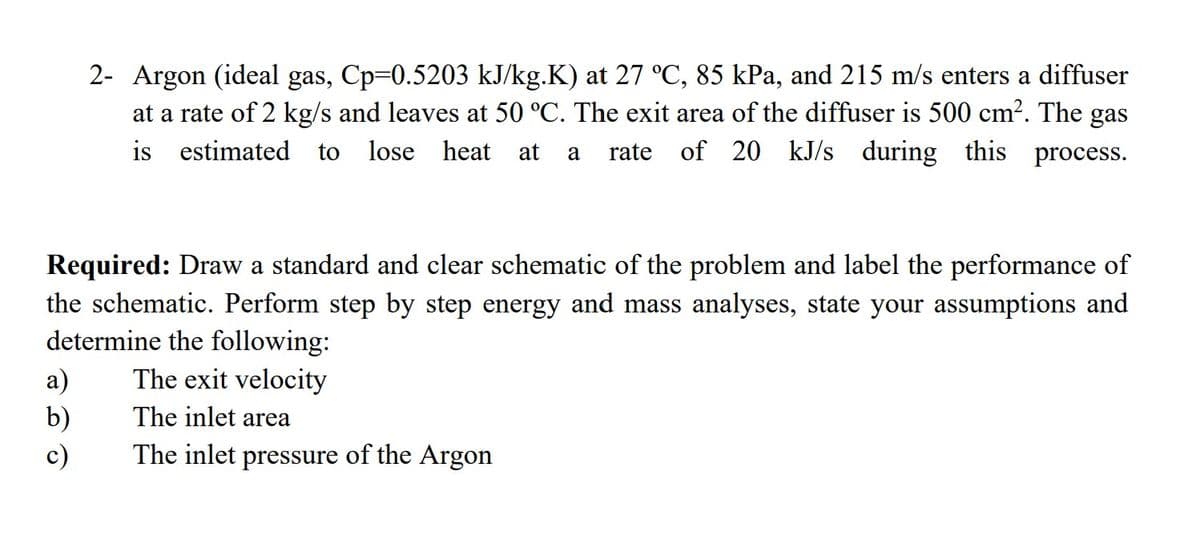Argon (ideal gas, Cp=0.5203 kJ/kg.K) at 27 ºC, 85 kPa, and 215 m/s enters a diffuser at a rate of 2 kg/s and leaves at 50 ºC. The exit area of the diffuser is 500 cm2. The gas is estimated to lose heat at a rate of 20 kJ/s during this process. Required: Draw a standard and clear schematic of the problem and label the performance of the schematic. Perform step by step energy and mass analyses, state your assumptions and determine the following: a) The exit velocity b) The inlet area c) The inlet pressure of the Argon
Argon (ideal gas, Cp=0.5203 kJ/kg.K) at 27 ºC, 85 kPa, and 215 m/s enters a diffuser at a rate of 2 kg/s and leaves at 50 ºC. The exit area of the diffuser is 500 cm2. The gas is estimated to lose heat at a rate of 20 kJ/s during this process. Required: Draw a standard and clear schematic of the problem and label the performance of the schematic. Perform step by step energy and mass analyses, state your assumptions and determine the following: a) The exit velocity b) The inlet area c) The inlet pressure of the Argon
Elements Of Electromagnetics
7th Edition
ISBN:9780190698614
Author:Sadiku, Matthew N. O.
Publisher:Sadiku, Matthew N. O.
ChapterMA: Math Assessment
Section: Chapter Questions
Problem 1.1MA
Related questions
Question
2) Argon (ideal gas, Cp=0.5203 kJ/kg.K) at 27 ºC, 85 kPa, and 215 m/s enters a diffuser at a rate of 2 kg/s and leaves at 50 ºC. The exit area of the diffuser is 500 cm2. The gas is estimated to lose heat at a rate of 20 kJ/s during this process.
Required: Draw a standard and clear schematic of the problem and label the performance of the schematic. Perform step by step energy and mass analyses, state your assumptions and determine the following:
a) The exit velocity
b) The inlet area
c) The inlet pressure of the Argon

Transcribed Image Text:2- Argon (ideal gas, Cp=0.5203 kJ/kg.K) at 27 °C, 85 kPa, and 215 m/s enters a diffuser
at a rate of 2 kg/s and leaves at 50 °C. The exit area of the diffuser is 500 cm?. The gas
is estimated
to
lose heat
at
rate of 20 kJ/s during this process.
a
Required: Draw a standard and clear schematic of the problem and label the performance of
the schematic. Perform step by step energy and mass analyses, state your assumptions and
determine the following:
The exit velocity
a)
b)
c)
The inlet area
The inlet pressure of the Argon
Expert Solution
This question has been solved!
Explore an expertly crafted, step-by-step solution for a thorough understanding of key concepts.
Step by step
Solved in 4 steps with 5 images

Knowledge Booster
Learn more about
Need a deep-dive on the concept behind this application? Look no further. Learn more about this topic, mechanical-engineering and related others by exploring similar questions and additional content below.Recommended textbooks for you

Elements Of Electromagnetics
Mechanical Engineering
ISBN:
9780190698614
Author:
Sadiku, Matthew N. O.
Publisher:
Oxford University Press

Mechanics of Materials (10th Edition)
Mechanical Engineering
ISBN:
9780134319650
Author:
Russell C. Hibbeler
Publisher:
PEARSON

Thermodynamics: An Engineering Approach
Mechanical Engineering
ISBN:
9781259822674
Author:
Yunus A. Cengel Dr., Michael A. Boles
Publisher:
McGraw-Hill Education

Elements Of Electromagnetics
Mechanical Engineering
ISBN:
9780190698614
Author:
Sadiku, Matthew N. O.
Publisher:
Oxford University Press

Mechanics of Materials (10th Edition)
Mechanical Engineering
ISBN:
9780134319650
Author:
Russell C. Hibbeler
Publisher:
PEARSON

Thermodynamics: An Engineering Approach
Mechanical Engineering
ISBN:
9781259822674
Author:
Yunus A. Cengel Dr., Michael A. Boles
Publisher:
McGraw-Hill Education

Control Systems Engineering
Mechanical Engineering
ISBN:
9781118170519
Author:
Norman S. Nise
Publisher:
WILEY

Mechanics of Materials (MindTap Course List)
Mechanical Engineering
ISBN:
9781337093347
Author:
Barry J. Goodno, James M. Gere
Publisher:
Cengage Learning

Engineering Mechanics: Statics
Mechanical Engineering
ISBN:
9781118807330
Author:
James L. Meriam, L. G. Kraige, J. N. Bolton
Publisher:
WILEY